ons-stats
ONS Statistics
Analysis of Excess Deaths
Author: Michael George
Created: 12 May 2020
Project: GitHub
Overview
My recent study of deaths during 2020 used a number of datasets from Office for National Statistics ONS.
This document describes how I made use of the ONS data so that it could be presented as accurately and clearly as possible.
A significant portion of the data was the actual number of daily deaths between January 1970 to December 2018. Provisional daily figures for January 2019 to July 2019 were also taken from the Excess Winter Deaths report published by the ONS in November 2019. Weekly figures for August 2019 onwards were taken from the most recent publication of weekly death registrations from the ONS.
-
Daily deaths between January 1970 to July 2019 were downloaded from the ONS website and are based on the date of occurrence. The daily deaths were rolled up into weekly, monthly and quadrimester periods using SQL and MariaDB.
-
Weekly death registrations for August 2019 to July 2020 were extracted from the weekly ONS datasets. All of the weekly data was processed using Python and Excel to accurately reflect when deaths were likely to have occurred during 2020.
Weekly death registrations are subject to noticeable delays, especially around bank holidays. This mandates the need to “clean up” the registration data so that it can be realistically compared to the historical data (based on the date of occurrence), accounting for registration delays (median of 5 days) and the pronounced effect of bank holidays.
Note: The median time for a death to be registered in England and Wales is 5 days with 74% of all deaths being registered within 7 calendar days, according to the latest analysis by the ONS.
2019/2020
TLDR; I have created a process that converts the 2019/2020 weekly registration data into something that accurately represents the weekly occurrences. This document describes the process and why it can be regarded as an accurate representation of weekly deaths during 2020.
Note that the total number of deaths is unchanged and the overall peak is slightly lower after the data processing described within this document. The data processing has simply made the weekly death registrations more accurate (reflecting date of occurrence) and has in no ways exaggerated the weekly figures.

Date of Registration vs Date of Occurrence
All of the historical data (January 1970 to July 2019) used in my study is based on the date of occurrence. When the daily data is converted into weekly periods and shown graphically it results in a smooth trend showing how many people died each week.
The weekly registration data from the ONS for Aug 2019 to Jul 2020 is based on the date of registration. When the registration data is shown graphically it shows a slight lag and significant weekly fluctuations, especially during and after the weeks that contain a bank holiday. This can clearly be illustrated by comparing the registrations and occurrences for the past years; see below for 2014/2015 and 2017/2018.
The data and graphs shown below can be found in the spreadsheet “ons_weekly_deaths.xlsx” which is in the project “data” folder.
Example 1 - 2014/2015
Aside from a slight lag, bank holidays can clearly be seen as a sudden drop followed by a spike in the weekly registrations.

Example 2 - 2017/2018
In addition to the lag and effect of bank holidays, week 9 contains an unexpected dip. This unexpected dip is made up for during the weeks that follow; weeks 10 and 11.
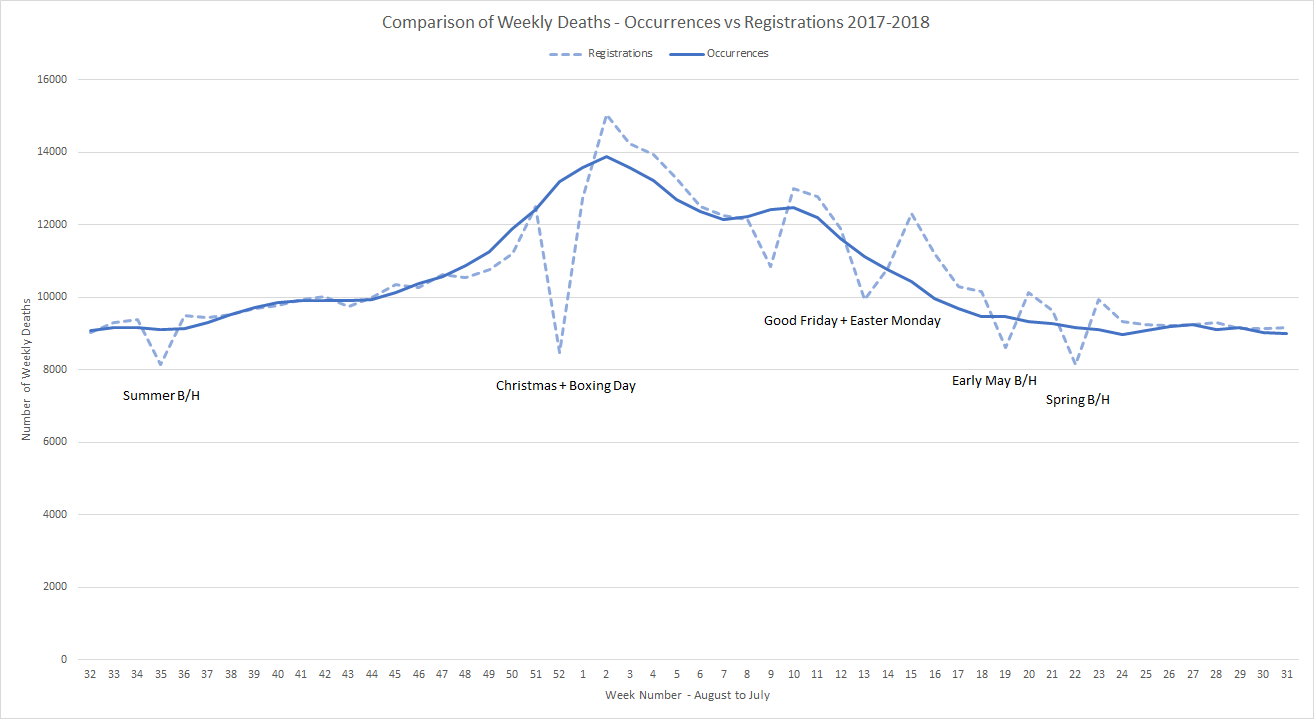
Daily COVID-19 Deaths
Daily death occurrences where COVID-19 was mentioned on the death certificate
The daily occurrence data is a relatively clean distribution, especially when shown as a 7-day trend using a centred moving average.

Daily death registrations where COVID-19 was mentioned on the death certificate
Death registrations typically occur Monday to Friday but during the Easter period, registry offices were also open on the Saturday to try to minimise the impact of registration delays.
The daily registration data looks pretty messy, although it is slightly improved when shown as a 7-day trend using a centralised moving average. The effect of bank holidays on the timeliness of COVID-19 related death registrations is highlighted in dark red.
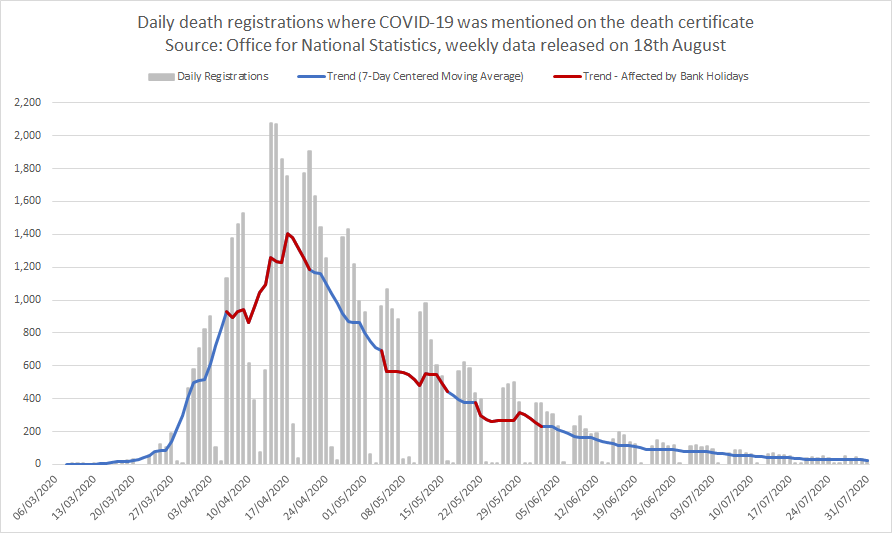
Weekly COVID-19 Deaths
Date of Registration vs Date of Occurrence
In addition to all-cause weekly mortality data the ONS are publishing COVID-19 specific data; based on the date of registration and the date of occurrence. When both are shown together it is possible to see the lag effects; registration delays and bank holidays.
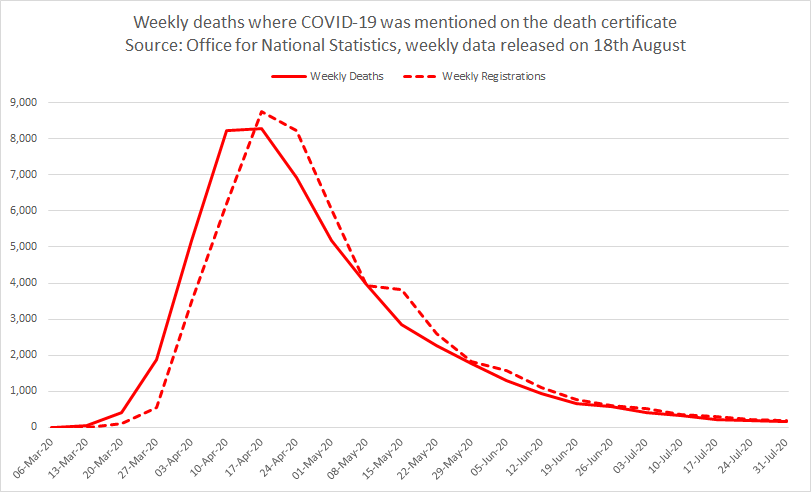
Accounting for Registration Delays
The median time for registration is 5 days and it can be easily proven using the daily COVID-19 data. I haven’t included it in this article but it is possible to compare the “totals to date” for both registrations and occurrences to confirm the 5 day lag.
To account for the delays in weekly registration data, I have used a simple process which takes a fixed percentage of deaths from the current week and a fixed percentage of deaths from the following week. I determined the optimal percentages using a Python script using the historical data from 2017 and 2018 and also confirmed the effectiveness visually.
The Python script calculates the root-mean-square deviation (RMSD) to determine the optimal percentages for 2017/2018; 47% and 53%.
Applying the 2017/2018 percentages to the weekly COVID-19 registrations results in the graph below. This gives additional confirmation that the 2017 and 2018 parameters also work really well for 2020.
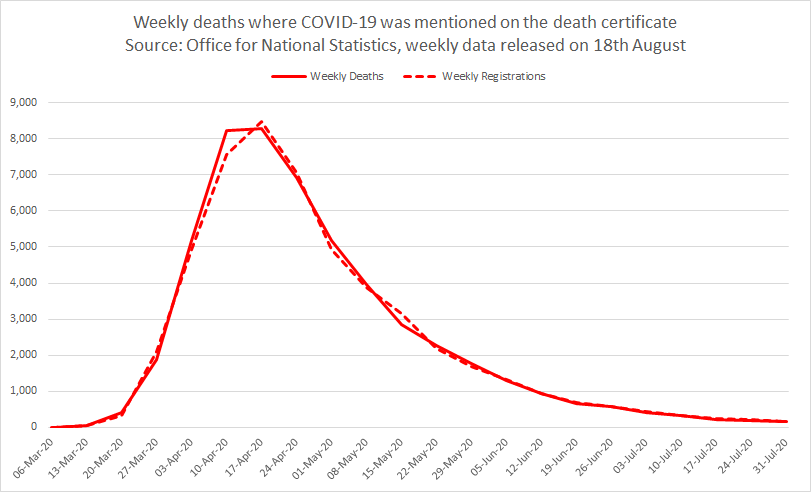
Processing 2019/2020
Should you wish to look more closely the entire processing can be found within the spreadsheet “ons_weekly_deaths_2020.xlsx” on GitHub.
The graph below shows the raw weekly registration data for all causes (blue) and where COVID-19 appears on the certificate (red).
As has already been mentioned earlier, exact numbers and dates for the COVID-19 related deaths are published by the ONS and this process is mainly to determine an accurate representation of all cause mortality during the same period (blue).
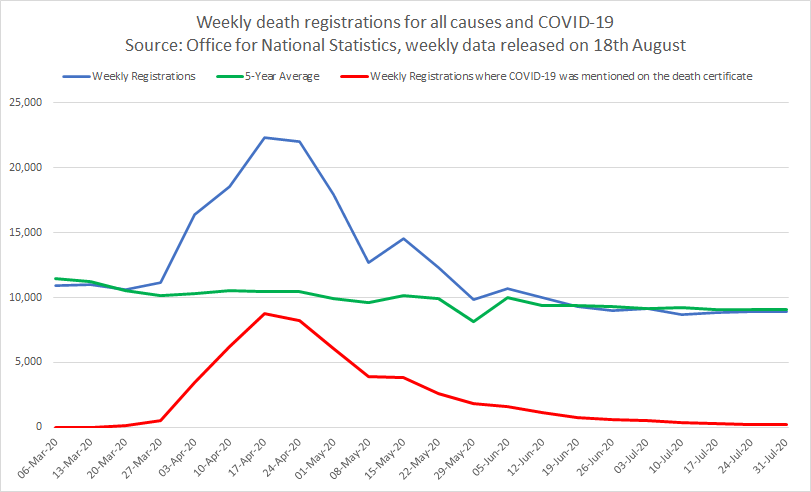
Showing the same data in a slightly different form it is possible to highlight where bank holidays had a significant impact on death registrations.
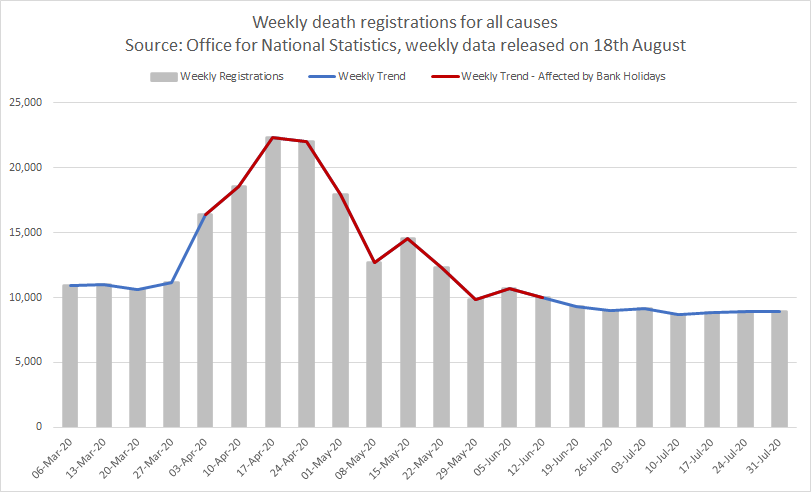
Step 1
The first step is to remove all of the COVID-19 death registrations. This is very simple as the number of weekly COVID-19 registrations is provided by the ONS. This leaves the weekly registrations where COVID-19 was NOT implicated in the deaths.

Step 2
The non-COVID registrations are adjusted / smoothed to account for the obvious bank holiday delays.
It is important to note that the total number of deaths is unchanged and the overall peak is NOT changed by this process.
Essentially, some deaths are brought forward where their registration was delayed due to a bank holidays.

Step 3
The next step is a simple shift using the parameters that were determined by the Python script using ONS data for the whole of 2017 and 2018. The Python script used root-mean-square deviation (RMSD) as the measure of “best fit” which turned out to be 47% and 53%. An illustration of the suitability of these parameters for 2020 data can be found earlier in this document, showing the deaths where COVID-19 was implicated and the effect of shifting the data.
The graph below shows the deaths where COVID-19 was not implicated, shifted left to account for registration delays.

Step 4
The final step is to re-introduce the COVID deaths based on the date of occurrence, resulting in the total number weekly deaths for all causes (shown in blue).
The red line is the original ONS data without any additional processing. You should notice how the peaks for these two distributions are still aligned (w/e Friday 10th April) which corresponds to the daily peak in COVID-19 implicated deaths which was Wed 8th April.

Review
Comparison with Weekly Registrations
The graph below shows the “before” and “after” for weekly death registrations from the ONS.
The solid blue line is the result of the processing described within this document whereas the solid red line is unmodified ONS data.
Note that the total number of deaths is unchanged and the overall peak is slightly lower after the data processing described within this document. The data processing has simply made the weekly death registrations more accurate (reflecting date of occurrence) and has in no ways exaggerated the weekly figures.

Comparison with Daily Death Registrations
The graph below the output of this processing, relative to the 5-year average.
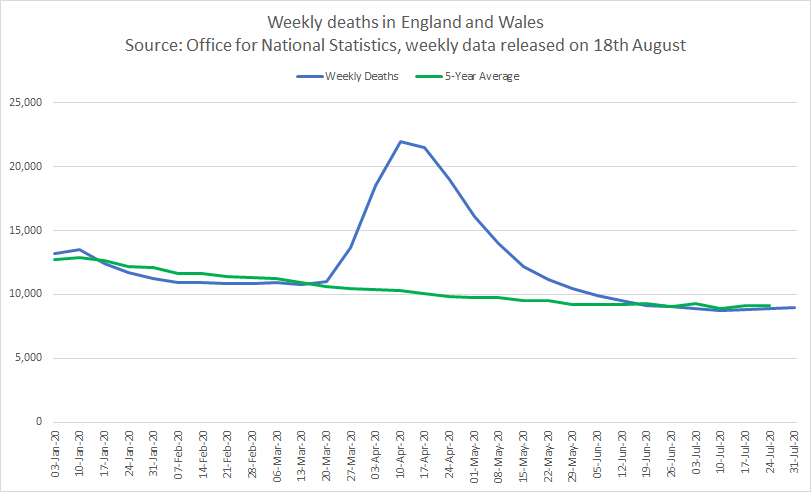
It is useful to compare my results against a graph that appears in the weekly COVID-19 surveillance report from Public Health England (PHE). They receive daily registration data from the General Register Office (GRO) and adjust it to allow for registration delays using historical data and their own statistics. I would expect this PHE daily data to follow a similar trend to the corresponding weekly data.
It is easy to compare my weekly data (see above - blue and green) with the PHE daily data (see below - black and blue). The fact that both distributions are so similar gives my additional confidence that the process described in this document has produced an accurate result.
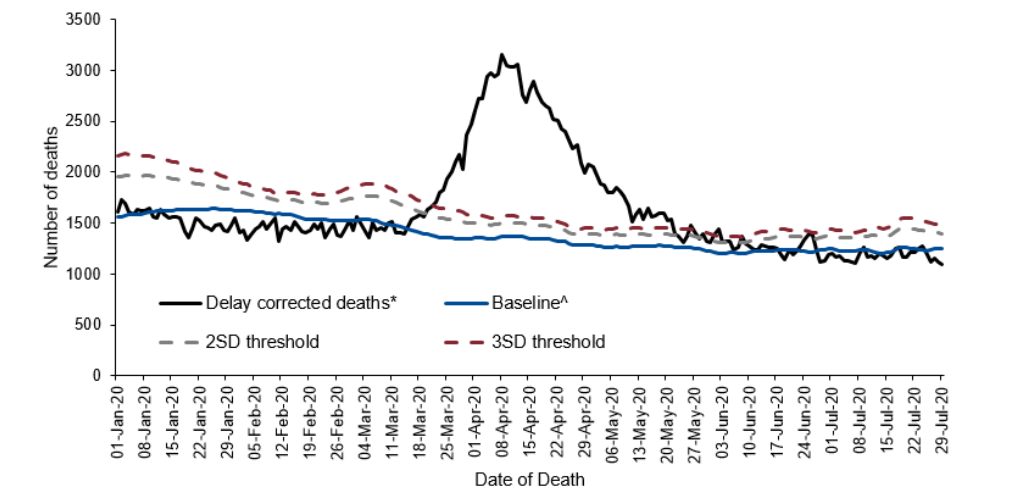
Summary
I’m extremely happy with the end result of this processing as it has allowed me to show an accurate representation of weekly deaths (based on date of occurrence) compared to historical data in my study of excess deaths over the past 50 years.
The main spreadsheet for the study is “ons_weekly_deaths.xlsx” and it can be found on GitHub.
Aside from this processing the rest of the data preparation for the study was relatively straightforward and was completed using SQL.
All of the data and scripts can be found in the project on GitHub.
Appendix - Data Sources
Daily death occurrences, England and Wales: 1970 to 2018
Summary: ONS datasets were used to produce “daily_deaths_1970-2018.csv” and they were loaded into MariaDB using SQL.
Data for Jan 1970 - Dec 2014
Downloaded the spreadsheet associated with request 005549 - “Daily death occurrences, 1970-2014.xlsx”.
The data came from the worksheet named “National daily deaths”. The year + month + day were converted to yyyy-mm-dd.
Data for Jan 2015 - Dec 2018
Downloaded the spreadsheet associated with request 11178 - “dailydeathsfinal.xlsx”.
The data came from the worksheet named “Table”. The year + month + day were converted to yyyy-mm-dd.
SQL Scripts
The scripts “create_daily_deaths.sql” and “insert_daily_deaths_1970-2018.sql” were used to load the CSV into MariaDB.
Daily death occurrences, England and Wales (provisional): 2019
The dataset accompanying the Excess Winter Mortality publication was used to produce “daily_deaths_provisional_2019.csv”.
Data for Jan 2019 - Jul 2019
Downloaded the spreadsheet associated with Excess winter mortality in England and Wales (2018-2019) - “referencetable.xls”.
The data in the worksheets named “3a” (England) and “3b” (Wales) was combined and saved as a CSV.
SQL Script
The script “insert_daily_deaths_provisional_2019.sql” was used to load the CSV into MariaDB.
Deaths registered weekly in England and Wales, provisional: 2019
Data for Aug 2019 - Dec 2019
Downloaded the latest spreadsheet for 2019 from Deaths registered weekly in England and Wales, provisional: 2019 - “publishedweek522019.xls”.
Deaths registered weekly in England and Wales, provisional: 2020
Data for Jan 2020 - Jul 2020
Downloaded the latest spreadsheet for 2020 from Deaths registered weekly in England and Wales, provisional: 2020 - “publishedweek282020.xlsx”.